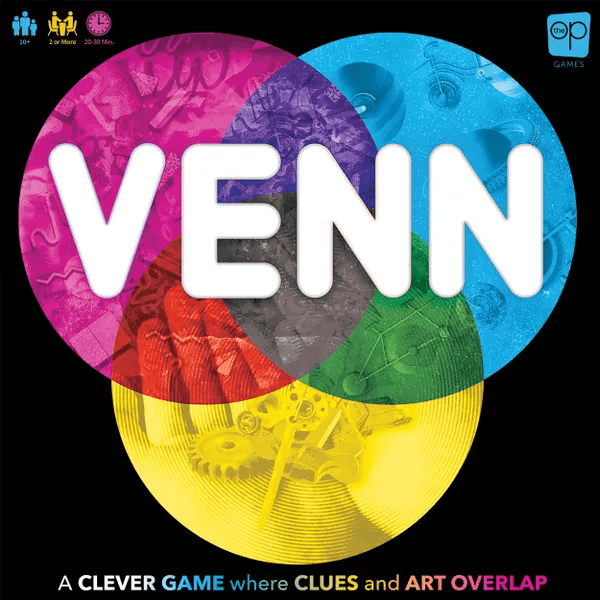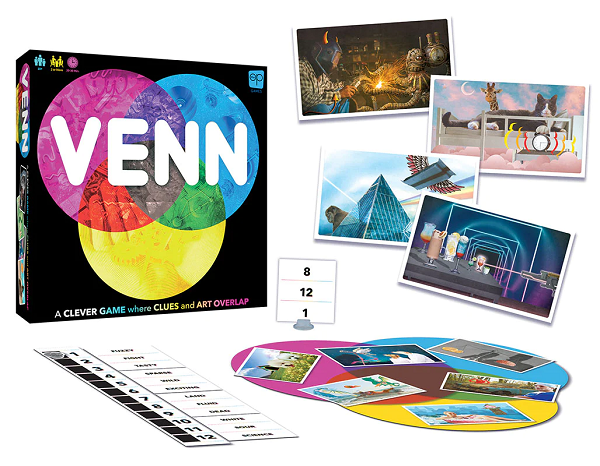Decipher Art, Diagrams, and Clues in Venn

Can you figure out your teammate’s clues in the Venn diagram and deduce which word each circle in the diagram is meant to represent?
Published by The Op, Venn is a party game about art-based clues and Venn diagrams, which can be played in teams or cooperatively.
Gameplay
Players split into two teams, and each team takes three different colored circles and sets them up to create a Venn diagram. The Venn diagram consists of three circles that partially overlap each other, to represent three different categories. If an object fits into one of the categories but not the other two, you place it so that it is in the portion of that category’s circle that is not overlapping either of the other two. If an object fits two or even three categories, you place it where those circles overlap.
The score track, with numbers one through twelve, is placed on the table and word cards are drawn and laid alongside the track so that each number corresponds to one word. Next, you divide the art cards into roughly three stacks, give one to each team, and place the third in the center of the table.
For each round, each team selects one player to be their clue giver. Each clue giver draws a number card to use during the round. This card gives you three numbers. The clue giver checks which words correspond to those numbers along the score track. These are the words he is trying to get his team to guess. Each word will correspond to a different circle in the team’s Venn diagram. When both teams are ready, the round starts.
Both teams act simultaneously. The clue giver on your team goes through his art cards, searching for cards to represent his words. When he chooses a card to play, he places it on the appropriate location in the team’s Venn diagram. There can only be one card in each of the seven sections of the diagram (the three sections that do not overlap at all, the three sections where two circles overlap, and the single section where all three circles overlap). However, if the clue giver finds a card he prefers to one that has already been played, he may place it on top of that card, covering it up. At any time, the clue giver can swap his stack of art cards for those in the center of the table.
At any time, once a clue giver has played at least three cards, his team can shout “Venn!”. Both teams stop, and the team that shouted guesses which three words they believe are represented by their Venn diagram. They earn one point for each correct guess and a bonus point if they guess all three. The opposing team then gets to make a guess as to their words, but they are not eligible for the bonus point.
To set up a new round, new word cards are dealt and a new clue giver is chosen for both teams. Once a team reaches twelve points, it is the final round and the team with the most points wins the game.
There is also a cooperative rule set where everyone is on a single team. It plays much the same, except that the team has only two minutes each round for clues to be given, the goal is to reach twelve points within five rounds, and there is no bonus point for guessing all three words.

Review
There are a number of party games on the market now that involve using the art on cards to give players various types of clues. However, Venn does manage to set itself apart with its core concept, as Venn diagrams can be both aesthetically and mentally appealing.
Many people are going to come to the game already familiar with Venn diagrams, and for players unfamiliar with the concept it’s not too hard to explain and the rulebook provides some helpful descriptions.
The simultaneous nature of the competitive mode, with both teams trying to race each other to their solutions, and the prospect of that potential bonus point, adds an appealing layer to the competitive gameplay, while the option of a cooperative mode allows the game to be played at a lower player count. If you do have enough players, we definitely recommend the competitive mode.
Venn’s artwork is surreal and absurd. It sets the game apart somewhat from other art-based clue-giving games, but it won’t appeal to all players. The art cards are also a large size. This is great for making the pictures easily visible, but it does make them a little large for the Venn circles, specifically for the sections where the circles overlap. Guessers can still tell more or less where clues are supposed to go, but it does ruin some of the visual appeal of the diagrams.
You may already have a lot of similar games in your collection, in which case you might decide to pass on Venn, but judged on its own merits it’s enjoyable and nicely put together. The design is clever, striking a balance between challenging and with enough information on the table to give players a chance at guessing the words correctly, while it adjusts nicely for a range of player counts.
Pros: Venn diagrams are fun to play with, fun racing aspect of the competitive mode, wide range of players supported
Cons: Art cards are little large for the circles, you may already have similar games in your collection
Disclosure: we received a complimentary review copy of this game.







